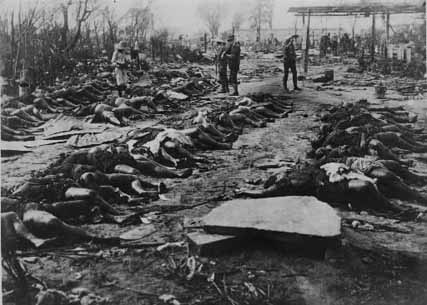”Never-before-published” photos of Hiroshima are, in reality, images of the Great Kanto Earthquake
May 15, 2008
Photographs used by an American historian in his recent book and on his website, alleged to be “never-before-published photographs” of the aftermath of the bombing of Hiroshima, have proven to be, instead, images of the Great Kanto Earthquake of 1923. This finding was made through a joint investigation by Hiroshima Peace Memorial Museum and the Chugoku Shimbun. Many websites in the United States posted the erroneous news of these ten photographs and media outlets in Europe reported the story as well. Le Monde, a major newspaper in France, produced an article about the “newly discovered” photographs and then issued a retraction on March 13, 2008. However, the misinformation resulting from this error has continued to spread.
Sean L. Malloy, an Assistant Professor at the University of California, Merced, recently published a book entitled “Atomic Tragedy” which focuses on Henry L. Stimson, the U.S. Secretary of War during the time the atomic bombs were developed and dropped on Hiroshima and Nagasaki in 1945. In his book, Mr. Malloy used three photographs that depict the carnage of dead bodies and include captions with such text as “immediate aftermath at Hiroshima by an unidentified Japanese photographer,” “ten images discovered after the war by an American soldier,” and “photos were among rolls of undeveloped film hidden in a cave on the outskirts of Hiroshima.”
At the same time, Mr. Malloy posted the ten images on his website, including the three contained in his book, with the explanation that the photographs were donated to the Hoover Institution Archives at Stanford University in 1998, by the soldier, Robert L. Capp, with the provision that they not be reproduced until 2008.
Hiroshima Peace Memorial Museum and the Chugoku Shimbun learned about the ten photographs on May 7 and determined through its investigation that they were, in reality, not images of Hiroshima. Some reasons for this conclusion include the fact that the clothes worn by the rescue workers in these images differ from outfits of World War II and the buildings which appear in the background did not resemble structures found in Hiroshima. Under the assumption that the photographs were actually taken after the Great Kanto Earthquake of 1923, an organization in Tokyo with expertise on the earthquake was contacted and they confirmed this suspicion. Six of the ten images in question are contained in a photo collection of the Great Kanto Earthquake and, in all likelihood, the others were also taken in the aftermath of the earthquake, judging by the surroundings.
In response to correspondence from Hiroshima Peace Memorial Museum and the Chugoku Shimbun, Mr. Malloy commented through email that “Though my use of the photos was based on the original designation at the Hoover Archives, I deeply regret my own failure to take additional steps to verify that the archival designation was correct.” He has since removed the ten images from his website.
Sean L. Malloy, an Assistant Professor at the University of California, Merced, recently published a book entitled “Atomic Tragedy” which focuses on Henry L. Stimson, the U.S. Secretary of War during the time the atomic bombs were developed and dropped on Hiroshima and Nagasaki in 1945. In his book, Mr. Malloy used three photographs that depict the carnage of dead bodies and include captions with such text as “immediate aftermath at Hiroshima by an unidentified Japanese photographer,” “ten images discovered after the war by an American soldier,” and “photos were among rolls of undeveloped film hidden in a cave on the outskirts of Hiroshima.”
At the same time, Mr. Malloy posted the ten images on his website, including the three contained in his book, with the explanation that the photographs were donated to the Hoover Institution Archives at Stanford University in 1998, by the soldier, Robert L. Capp, with the provision that they not be reproduced until 2008.
Hiroshima Peace Memorial Museum and the Chugoku Shimbun learned about the ten photographs on May 7 and determined through its investigation that they were, in reality, not images of Hiroshima. Some reasons for this conclusion include the fact that the clothes worn by the rescue workers in these images differ from outfits of World War II and the buildings which appear in the background did not resemble structures found in Hiroshima. Under the assumption that the photographs were actually taken after the Great Kanto Earthquake of 1923, an organization in Tokyo with expertise on the earthquake was contacted and they confirmed this suspicion. Six of the ten images in question are contained in a photo collection of the Great Kanto Earthquake and, in all likelihood, the others were also taken in the aftermath of the earthquake, judging by the surroundings.
In response to correspondence from Hiroshima Peace Memorial Museum and the Chugoku Shimbun, Mr. Malloy commented through email that “Though my use of the photos was based on the original designation at the Hoover Archives, I deeply regret my own failure to take additional steps to verify that the archival designation was correct.” He has since removed the ten images from his website.








